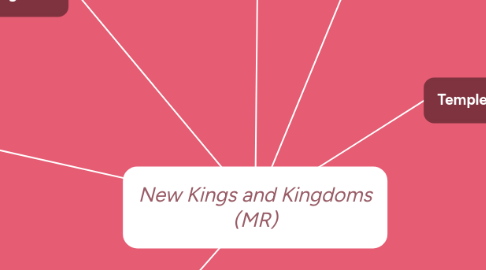
1. Administration in Kingdoms
1.1. Collection of taxes: peasants, artisans, cattle keepers and traders
1.1.1. Waging wars and collecting more wealth and land
1.1.2. Invested in constructing forts and palaces
2. Features\Political Culture of Medieval India
2.1. Fluctuating Frontiers
2.1.1. Kanauj and the Tripartite struggle
2.2. Display of Wealth and power through construction of grand temples
2.2.1. Gangaikondacholapuram
2.3. Attacking and looting of worship places
2.3.1. Attack on somnath
2.3.2. Attack on Sri Lanka
3. Case study of Cholas
3.1. Agriculture and Irrigation
3.1.1. Kaveri
3.1.1.1. Fertile lands as a result frequent flooding of the banks with mineral rich soil
3.1.1.1.1. Agricultural Surplus
3.1.2. Steps taken to further encourage agriculture
3.1.2.1. Cutting of forests
3.1.2.2. Leveling of Land
3.1.2.3. Embankment
3.1.2.3.1. Canals
3.1.2.4. Artificial Irrigation
3.1.2.4.1. Tanks
3.1.2.4.2. Wells
3.2. Administration
3.2.1. Central Government
3.2.1.1. The Chola king
3.2.2. Nadu
3.2.2.1. Formed out of groups of Ur Performed administrative functions
3.2.3. Ur
3.2.3.1. Settlements of peasants- villages
3.2.4. Sabha
3.2.4.1. Assembly of prominent Brahmana landholders.
3.2.4.1.1. Functions
3.2.4.1.2. Membership
3.2.5. Nagaram
3.2.5.1. Associations of traders
4. Samantas
4.1. Duties
4.1.1. Collect Taxes
4.1.2. Be present at their courts
4.1.3. Provide them with military support.
4.1.4. Bring Gifts
4.2. Big landlords or warrior chiefs
4.2.1. They were expected to bring gifts for their kings or overlords
4.3. Transformation in to Kings
4.3.1. Rashtrakutas
4.3.1.1. Ceremony of Hiranya Garbha
4.3.1.2. Role of the Brahmins
4.3.2. Kadambas and Gurjara Pratiharas
5. Sources
5.1. Prashastis
5.1.1. Limitations\Problems: Exaggerations or intentional editing of information does not provide the historian a complete or correct picture of the individual etc.
5.1.2. Author: Court Bards and Brahmins
5.1.3. Language: Courtly language of Sanskrit
5.1.4. Content: Often exaggerated descriptions to make their employer happy i.e. the king
5.1.5. Rewards: Important positions in the court, land grant or monetary gains
5.2. Land grants
5.2.1. Copper Plates: Inscribed with the details of the grant bearing the royal seal for authenticity
5.2.2. Granted by the king to Brahmanas
5.2.2.1. Often written in local languages
5.2.2.2. Land grant often included wells, villages, fruit orchards , garden etc
5.3. Long Poems
5.3.1. Written in sanskrit as well as regional languages
5.3.2. Prithviraj Raso by Chandbardai
5.3.3. Kalhan's Rajtarangini
5.3.3.1. Used multiple sources to trace the long line of kings in Kashmir
5.3.3.2. Written by Chandbardai a courtier in the court of Prithviraj Chauhan
5.3.3.3. Often critical of the kings
6. Temples : Nuclei of settlements
6.1. Economic
6.1.1. Temples often acted as banking institutions and lend money for trade
6.1.2. generated jobs for cooks, sweepers, flower seller, sculptors. Centres of craft production.
6.2. Social
6.2.1. Often a place used for meeting and discussion
6.3. Cultural Hub
6.3.1. Festivals celebrated on a grand scale
6.3.2. Gave birth to new dances, music and songs
6.4. Settlements came up around the temple that housed brahmins, sculptors, farmers etc
6.4.1. Shops catering to pilgrims and their needs in order to pray at the temple
